Versatile actress Leda Gys (1892-1957) was the only Italian diva who never played vamp roles and the only one whose career lasted until the advent of sound films. She starred in some 80 dramas, comedies, action thrillers and even westerns of the Italian and Spanish silent cinema. Her claim to fame came with the film Christus (1916), shot in Egypt and Palestine, where Gys performed the Madonna.
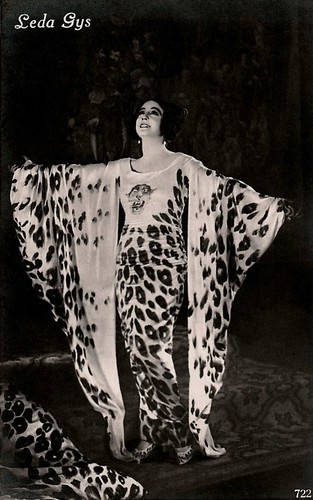
Italian postcard by Ed. A. Traldi, Milano (Milan), no. 722.
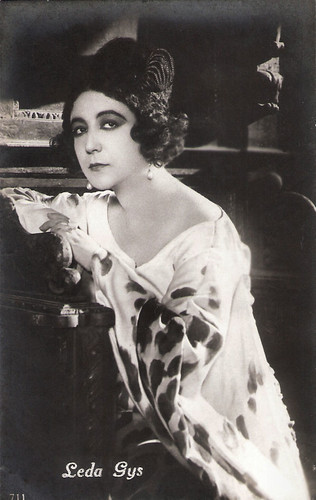
Italian postcard by Ed. A. Traldi, Milano, no. 711.
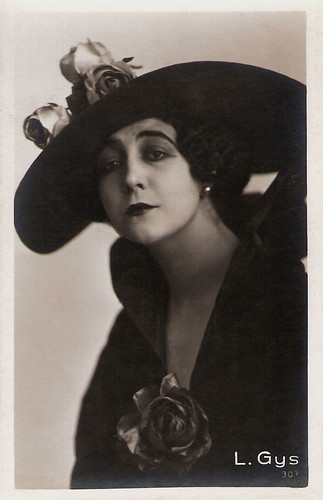
Italian postcard by Ed. G. Vettori, Bologna, no. 303.
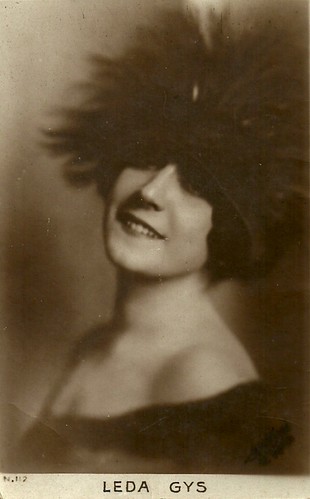
Italian postcard by Edit. Soc. Anon. It. Bettini, Roma, no. 112. Photo: Riccardo Bettini.

Italian postcard by Edit. Soc. Anon. It. Bettini, Roma, no. 113. Photo: Riccardo Bettini.

Italian postcard by Edit. Soc. Anon. It. Bettini, Roma, no. 201. Photo: Riccardo Bettini.

Italian postcard by Edit. Soc. Anon. It. Bettini, Roma, no. 237. Photo: Riccardo Bettini.

Italian postcard by Edit. Soc. Anon. It. Bettini, Roma, no. 238. Photo: Riccardo Bettini.
Leda Gys was born as Giselda Ilardi in Roma (Rome), Italy, in 1892.
Her lover, the Roman poet Carlo Alberto Trilussa introduced young Giselda to the Cines film studios in 1912. He also gave her her artist's name Leda Gys, by anagrammatising her Christian name, Giselda. Her film debut was the short silent Cines drama Fior d'amore e fior di morte/Flower of Love and Flower of Death (1912) with Amleto Novelli.
Gys quickly rose to leads in films like L'histoire d'un Pierrot/Pierrot the Prodigal (Baldassarre Negroni, 1914) with Francesca Bertini, L'amazzone mascherata/The Masked Amazon (Baldassarre Negroni, 1914) again with Bertini and with Emilio Ghione, La marcia nuziale/The Wedding March (Carmine Gallone, 1915) with Lyda Borelli, Maschera di mistero/Mask of Mystery (Mario Caserini, 1915) and La morta del lago/A Fatal Fascination (Enrico Guazzoni, 1915) with Pina Menichelli.
Italian-American film historian Angela Dalle Vacche writes in the Encyclopedia Of Early Cinema: "Working for both Cines and its branch Celio, between 1913 and 1914, she sharpened her skills in some two dozen short—or medium-length films directed by Enrico Guazzoni and others.
It was then that Gys began to develop a personal screen type based on American stars, combining the girl-next-door innocence of Mary Pickford and the suffering pathos of Lilian Gish."

Vintage postcard, printed in Italy but with English text. Gys's name is misspelled.
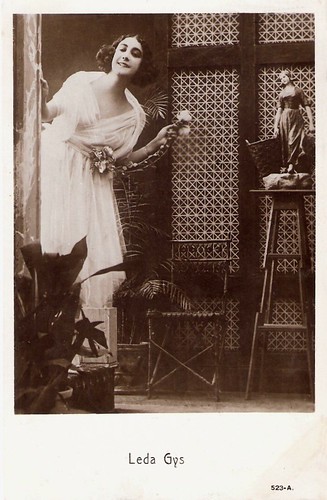
Vintage postcard, no. 523A, sent by mail from Belgium to the Netherlands in 1928.
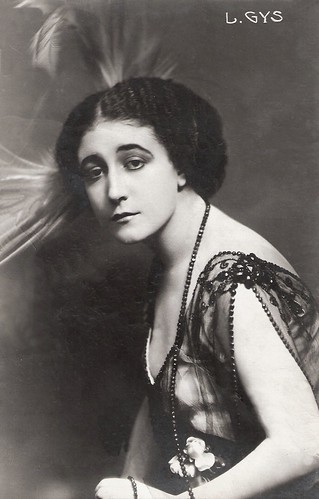
Vintage Italian postcard.
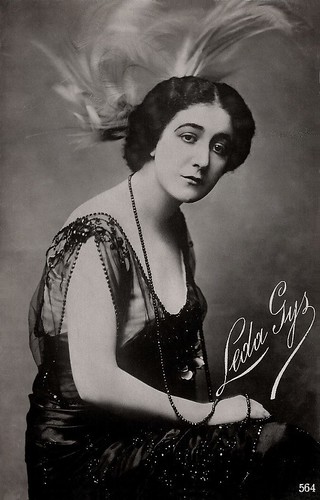
Italian postcard by Ed. A. Traldi, Milano, no. 564.

Italian postcard by Ed. Romeo Biagi, Bologna, no. 652.
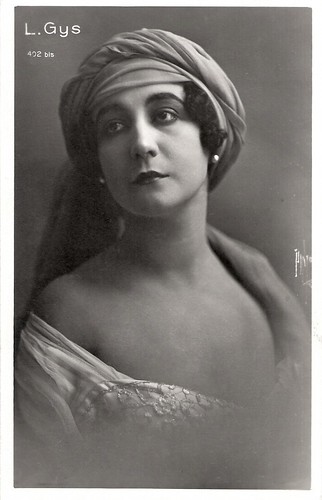
Italian postcard by Ed. Vettori, Bologna, no. 402 bis. Photo: Foto Pinto, Roma.

German postcard by Verlag Hermann Leiser, Berlin, no. 5652.
The versatile Leda Gys appeared in all kinds of genres: drama, comedy, action thrillers and even westerns. Often she played the pathetic roles of the romantic and innocent young woman, victim of loose mothers, unfaithful husbands, adventurers etc.
Her claim to fame came with Christus/Christ (Giulio Antamoro, 1916), a religious epic shot in Egypt and Palestine. Gys performed the Madonna and Alberto Pasquali appeared as Jesus Christ.
Various films in Spain followed, such as Flor de otoño/Autumn Flowers (Mario Caserini, 1916) with Maria Caserini, which led to the belief afterwards that she was a Spanish actress.
From the late 1910s on, Gys performed in Neapolitan dramas and comedies, produced by the Neapolitan producer and Gys' husband Gustavo Lombardo. Lombardo was inspired by American cinema and transposed the American modern style to Italian cinema, thus mixing Gys's characters with sentiment or wit.
These films like I figli di nessuno/Nobody's Children (Ubaldo Maria del Colle, 1921) and Napoli è una canzone/Naples Is A Song (Eugenio Perego, 1927), appealed to Italian emigrants in North and South America thanks to their shots of Naples and surroundings, their references to Neapolitan regional theatre and their intertitles in Neapolitan dialect.

French postcard, no. 7467. Photo: publicity still for La pantomima della morte/The pantomime of death (Mario Caserini, 1915) with Mario Bonnard. Collection: Didier Hanson.

Italian postcard by Ed. A. Traldi, Milano. Leda Gys and Mario Bonnard in the Italian silent film La pantomima della morte (Mario Caserini, 1915).

French postcard by J. Mayer, graveur, Paris. Photo: Films Primior, Paris. The Pietà with Jesus (Alberto Pasquali) and Mary (Leda Gys), from the silent epic Christus (Giulio Antamoro, 1916).

Spanish cromo (collectors card) by Chocolate Pi, Barcelona, card 9. Photo: Distr. J. Pich, Barcelona / Cines. Scene from the film Amica (Enrico Guazzoni, 1916), starring Leda Gys, here with what seems to be Augusto Poggioli.

Spanish postcard by Chocolate Salas Sabadell. Leda Gys in the silent Italian film Fernanda (Gustavo Serena, 1917), based on Victorien Sardou's play.

Italian postcard. Leda Gys as protagonist of the film Treno di lusso (Mario Bonnard, 1917).

Italian postcard by G.B. Falci, Milano, no. 300. Photo: Leda Gys as Mimì in La Bohème (Amleto Palermi, 1917).
Throughout the 1920s Leda Gys did light-hearted romantic comedies directed by Eugenio Perego.
She also worked in France, where she made Esclave/Slave (Georges Monca, Rose Pansini, 1922) with the young Charles Boyer.
In 1929 she appeared in her last films, the Titanus productions Mi chiamano Mimì Rondine/Rondine (Eugenio Perego, 1929) with Adele Farulli, and La signorina Chicchiricchì/Miss Chicchiricchì (Eugenio Perego, 1929) with Silvio Orsini.
Just before the advent of the sound film, she withdrew from the cinema to take care of her son, Goffredo Lombardo. In the post-war years, Goffredo would be the producer of Titanus Film, the company founded by his father Gustavo Lombardo in 1908.
Leda Gys died in Rome in 1957. She was 65. In 1999, Gys was one of the divas of the silent Italian cinema, who was featured by Peter Delpeut in his beautiful compilation film Diva Dolorosa.

Spanish cromo (collectors card) by Chocolate Pi, Barcelona, card 5 of 6. Photo: Cosmpoli Film Leda Gys in Quando si ama (Giuseppe De Liguoro, 1917). The film was released in Spain as Cuando el amor se muere.
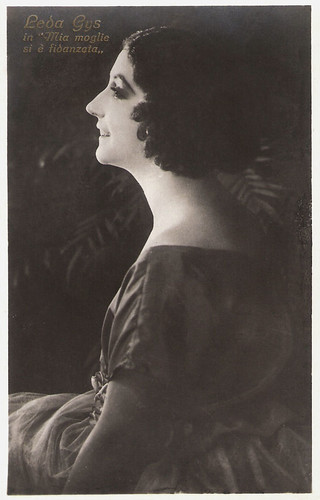
Italian postcard by G.B. Falci Editore, Milano, no. 309. Photo: publicity still for Mia moglie si è fidanzata/My wife got engaged (Gero Zambuto, 1921).
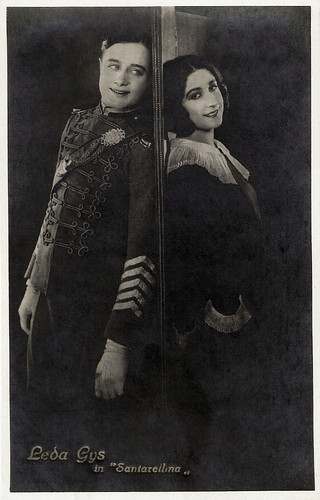
Italian postcard by G.B. Falci, Milano, no. 303. Photo: publicity still for Santarellina (Eugenio Perego, 1923) with Silvio Orsini.

Italian postcard by G.B. Falci, Milano, no. 322. Photo: Leda Gys in Santarellina (Eugenio Perego, 1923).

Italian postcard by S.A. Stef. Pittaluga. G.B. Falci, Milano, no. 592. Leda Gys and Silvio Orsini acted in 10 films together, between 1921 and 1929. While most of their films were produced by Lombardo Film, such as Napule... e niente cchiù (Eugenio Perego, 1928), only one film was produced by Pittaluga: I 28 giorni di Claretta (Eugenio Perego, 1927).
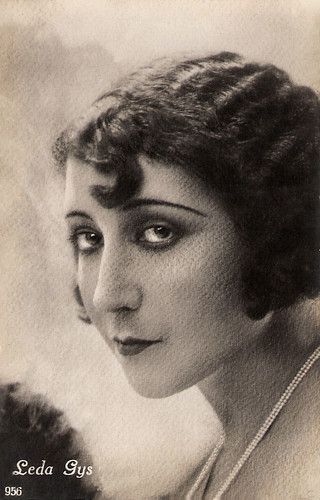
Italian postcard by Ed. A. Traldi, Milano, no. 956.

American postcard imported by Peter Caruggi & Brothers.
Histoire d'un Pierrot (Baldassarre Negroni, 1913). Source: Enrico Giacovelli (YouTube).
Clip from Diva Dolorosa (1999). Source: TheStat01 (YouTube). The clip is without Leda Gys.
Sources: Vittorio Martinelli (Le dive del silenzio), Angela Dalle Vacche (Encyclopedia Of Early Cinema), Wikipedia (Italian) and IMDb.
This post was last updated on 22 July 2024.

Italian postcard by Ed. A. Traldi, Milano (Milan), no. 722.

Italian postcard by Ed. A. Traldi, Milano, no. 711.

Italian postcard by Ed. G. Vettori, Bologna, no. 303.

Italian postcard by Edit. Soc. Anon. It. Bettini, Roma, no. 112. Photo: Riccardo Bettini.

Italian postcard by Edit. Soc. Anon. It. Bettini, Roma, no. 113. Photo: Riccardo Bettini.

Italian postcard by Edit. Soc. Anon. It. Bettini, Roma, no. 201. Photo: Riccardo Bettini.

Italian postcard by Edit. Soc. Anon. It. Bettini, Roma, no. 237. Photo: Riccardo Bettini.

Italian postcard by Edit. Soc. Anon. It. Bettini, Roma, no. 238. Photo: Riccardo Bettini.
Madonna
Leda Gys was born as Giselda Ilardi in Roma (Rome), Italy, in 1892.
Her lover, the Roman poet Carlo Alberto Trilussa introduced young Giselda to the Cines film studios in 1912. He also gave her her artist's name Leda Gys, by anagrammatising her Christian name, Giselda. Her film debut was the short silent Cines drama Fior d'amore e fior di morte/Flower of Love and Flower of Death (1912) with Amleto Novelli.
Gys quickly rose to leads in films like L'histoire d'un Pierrot/Pierrot the Prodigal (Baldassarre Negroni, 1914) with Francesca Bertini, L'amazzone mascherata/The Masked Amazon (Baldassarre Negroni, 1914) again with Bertini and with Emilio Ghione, La marcia nuziale/The Wedding March (Carmine Gallone, 1915) with Lyda Borelli, Maschera di mistero/Mask of Mystery (Mario Caserini, 1915) and La morta del lago/A Fatal Fascination (Enrico Guazzoni, 1915) with Pina Menichelli.
Italian-American film historian Angela Dalle Vacche writes in the Encyclopedia Of Early Cinema: "Working for both Cines and its branch Celio, between 1913 and 1914, she sharpened her skills in some two dozen short—or medium-length films directed by Enrico Guazzoni and others.
It was then that Gys began to develop a personal screen type based on American stars, combining the girl-next-door innocence of Mary Pickford and the suffering pathos of Lilian Gish."

Vintage postcard, printed in Italy but with English text. Gys's name is misspelled.

Vintage postcard, no. 523A, sent by mail from Belgium to the Netherlands in 1928.

Vintage Italian postcard.

Italian postcard by Ed. A. Traldi, Milano, no. 564.

Italian postcard by Ed. Romeo Biagi, Bologna, no. 652.

Italian postcard by Ed. Vettori, Bologna, no. 402 bis. Photo: Foto Pinto, Roma.

German postcard by Verlag Hermann Leiser, Berlin, no. 5652.
Neapolitan dramas and comedies
The versatile Leda Gys appeared in all kinds of genres: drama, comedy, action thrillers and even westerns. Often she played the pathetic roles of the romantic and innocent young woman, victim of loose mothers, unfaithful husbands, adventurers etc.
Her claim to fame came with Christus/Christ (Giulio Antamoro, 1916), a religious epic shot in Egypt and Palestine. Gys performed the Madonna and Alberto Pasquali appeared as Jesus Christ.
Various films in Spain followed, such as Flor de otoño/Autumn Flowers (Mario Caserini, 1916) with Maria Caserini, which led to the belief afterwards that she was a Spanish actress.
From the late 1910s on, Gys performed in Neapolitan dramas and comedies, produced by the Neapolitan producer and Gys' husband Gustavo Lombardo. Lombardo was inspired by American cinema and transposed the American modern style to Italian cinema, thus mixing Gys's characters with sentiment or wit.
These films like I figli di nessuno/Nobody's Children (Ubaldo Maria del Colle, 1921) and Napoli è una canzone/Naples Is A Song (Eugenio Perego, 1927), appealed to Italian emigrants in North and South America thanks to their shots of Naples and surroundings, their references to Neapolitan regional theatre and their intertitles in Neapolitan dialect.

French postcard, no. 7467. Photo: publicity still for La pantomima della morte/The pantomime of death (Mario Caserini, 1915) with Mario Bonnard. Collection: Didier Hanson.

Italian postcard by Ed. A. Traldi, Milano. Leda Gys and Mario Bonnard in the Italian silent film La pantomima della morte (Mario Caserini, 1915).

French postcard by J. Mayer, graveur, Paris. Photo: Films Primior, Paris. The Pietà with Jesus (Alberto Pasquali) and Mary (Leda Gys), from the silent epic Christus (Giulio Antamoro, 1916).

Spanish cromo (collectors card) by Chocolate Pi, Barcelona, card 9. Photo: Distr. J. Pich, Barcelona / Cines. Scene from the film Amica (Enrico Guazzoni, 1916), starring Leda Gys, here with what seems to be Augusto Poggioli.

Spanish postcard by Chocolate Salas Sabadell. Leda Gys in the silent Italian film Fernanda (Gustavo Serena, 1917), based on Victorien Sardou's play.

Italian postcard. Leda Gys as protagonist of the film Treno di lusso (Mario Bonnard, 1917).

Italian postcard by G.B. Falci, Milano, no. 300. Photo: Leda Gys as Mimì in La Bohème (Amleto Palermi, 1917).
Diva Dolorosa
Throughout the 1920s Leda Gys did light-hearted romantic comedies directed by Eugenio Perego.
She also worked in France, where she made Esclave/Slave (Georges Monca, Rose Pansini, 1922) with the young Charles Boyer.
In 1929 she appeared in her last films, the Titanus productions Mi chiamano Mimì Rondine/Rondine (Eugenio Perego, 1929) with Adele Farulli, and La signorina Chicchiricchì/Miss Chicchiricchì (Eugenio Perego, 1929) with Silvio Orsini.
Just before the advent of the sound film, she withdrew from the cinema to take care of her son, Goffredo Lombardo. In the post-war years, Goffredo would be the producer of Titanus Film, the company founded by his father Gustavo Lombardo in 1908.
Leda Gys died in Rome in 1957. She was 65. In 1999, Gys was one of the divas of the silent Italian cinema, who was featured by Peter Delpeut in his beautiful compilation film Diva Dolorosa.

Spanish cromo (collectors card) by Chocolate Pi, Barcelona, card 5 of 6. Photo: Cosmpoli Film Leda Gys in Quando si ama (Giuseppe De Liguoro, 1917). The film was released in Spain as Cuando el amor se muere.

Italian postcard by G.B. Falci Editore, Milano, no. 309. Photo: publicity still for Mia moglie si è fidanzata/My wife got engaged (Gero Zambuto, 1921).

Italian postcard by G.B. Falci, Milano, no. 303. Photo: publicity still for Santarellina (Eugenio Perego, 1923) with Silvio Orsini.

Italian postcard by G.B. Falci, Milano, no. 322. Photo: Leda Gys in Santarellina (Eugenio Perego, 1923).

Italian postcard by S.A. Stef. Pittaluga. G.B. Falci, Milano, no. 592. Leda Gys and Silvio Orsini acted in 10 films together, between 1921 and 1929. While most of their films were produced by Lombardo Film, such as Napule... e niente cchiù (Eugenio Perego, 1928), only one film was produced by Pittaluga: I 28 giorni di Claretta (Eugenio Perego, 1927).

Italian postcard by Ed. A. Traldi, Milano, no. 956.

American postcard imported by Peter Caruggi & Brothers.
Histoire d'un Pierrot (Baldassarre Negroni, 1913). Source: Enrico Giacovelli (YouTube).
Clip from Diva Dolorosa (1999). Source: TheStat01 (YouTube). The clip is without Leda Gys.
Sources: Vittorio Martinelli (Le dive del silenzio), Angela Dalle Vacche (Encyclopedia Of Early Cinema), Wikipedia (Italian) and IMDb.
This post was last updated on 22 July 2024.
1 comment:
Very nice, thanks.
Post a Comment